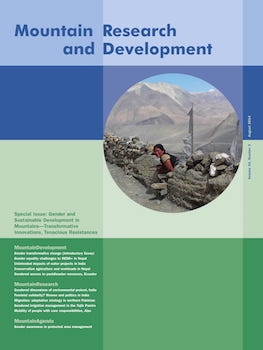High-Altitude Rangelands and Their Interfaces in the Hindu Kush Himalayas, edited by Wu Ning, Gopal S. Rawat, Srijana Joshi, Muhammad Ismail, and Eklabya Sharma. Kathmandu, Nepal: International Centre for Integrated Mountain Development, 2013. vi + 189 pp. Free download at lib.icimod.org/record/28840; hardcopy available upon request. ISBN 978-92-9115-291-9
The 2010 devastating floods in Pakistan were a striking reminder of how mountain rangelands management can affect people living downstream. While unprecedented climate factors triggered these floods, many other combined factors amplified their impact (Atta-ur-Rahman and Khan 2013). Deforestation, overgrazing, and cropping on steep slopes are all practices that occur in high-altitude rangelands of the Hindu Kush–Himalayas, destabilizing soils and increasing exposure to natural hazards. Mismanagement of high-altitude rangelands in the Hindu Kush–Himalayas is often the result of fragmented policies that fail to deliver sustainable development solutions for populations living in remote areas with scarce resources. As a consequence, poverty–environment nexuses are all the more deeply rooted in those systems.
The first chapter of the book sets the tone, explaining the ecological functions and the sensitivity of high-altitude rangeland interfaces, as well as their substantial importance for conservation and sustainable development. The authors underline the ecological functions of transitional belts that serve as semipermeable barriers between plant communities and that are rich in biodiversity. They also highlight 3 central characteristics of rangeland interfaces: (1) their influence on material flow between ecosystems, (2) their unique biodiversity patterns, and (3) their users' lack of awareness of the alterations they inflict on these systems. At the same time, these ecotones are becoming increasingly vulnerable due to the stressors mentioned above.
The following chapters are organized geographically, documenting the current conditions of the various high-altitude rangeland socioecological systems across the Hindu Kush–Himalayas. All chapters offer insights on landscape evolution over time under certain forms of land use. A development context is often brought to the fore, along with the need for capacity-building among local communities to reduce their impact. While most chapters in sections 1 and 2 address rangelands from an extensive livestock system perspective, sections 3 and 4 focus on wetlands, peatlands, and the potential of payment for ecosystem services (PES) for restoring high-altitude rangelands. PES is presented from a theoretical perspective and illustrated with empirical cases (eg PES in India's rangelands). These are analyzed in terms of the positive and negative effects that PES has had on the ecosystems concerned, as well as constraints on its implementation. However, more in-depth discussion of specific extensive pastoralism PES schemes in high-altitude pastures would have been insightful, as they have remained nearly inexistent to date.
The potential of cross-sectoral policies for addressing both conservation and livelihoods in Tajikistan brings a different angle to the book. Yet another chapter provides an in-depth analysis of timberline disturbances due to extensive pastoralism practices with selective foraging and pasture burning, which lower the tree-line ecotone on south-facing slopes. Had this tree line been undisturbed, it would have been much higher than that on the north-facing slopes.
Overall, the book offers a balanced mix of insights into both biological and socioecological processes. It is timely for 3 reasons. First, it marks the 30th anniversary of the International Centre for Integrated Mountain Development (ICIMOD) and commemorates three decades of working for sustainable development in the Hindu Kush–Himalayas, serving 210 million people in the region and a fifth of the world's population, who depend on water from rivers originating there. Second, the importance of mountains for people has recently been acknowledged in the Rio+20 resolution adopted by the General Assembly of the United Nations (Kohler et al 2012; UNCSD 2012; Ariza et al 2013), following their earlier inclusion in Agenda 21 (UNCED 1992) and at the Johannesburg Summit (WSSD 2002). Third, and in spite of this recognition, high-altitude rangelands often remain overlooked—a gap this book fills with a collection of articles that cover a wide geographical area and that take a transdisciplinary approach.
Nevertheless, the book would have gained further insight by addressing 3 additional issues. First, a future policy vision. Many of the problems that occur across the region and are addressed in the book have similar causes. A chapter on policy issues could have covered failed development approaches and presented ICIMOD's policy vision for the Hindu Kush–Himalayas at national and subnational levels and across various stakeholders (government agencies, donors, nongovernmental organizations [NGOs], and local communities). Recurrent fragmented policies in the region largely explain a sequence of failed development programs affecting certain communities. For example, landless mobile pastoralists in northern Pakistan face transhumance restrictions due to afforestation programs obstructing their transhumance routes (Ojeda et al 2012). In view of such failures, there is a need for cross-sectoral and more holistic policy approaches. A second issue that should have been addressed is that of interlinkages between mountain ecosystems across elevation strata. Management at a given ecosystem stratum has consequences for other strata. Landless mobile pastoralists in northern Pakistan, for example, are forced to accelerate their transhumance pace due to obstructed transhumance routes and limited resting places at lower elevations. As a consequence, they reach high-altitude summer pastures earlier in the season, and their animals begin to graze on sprouts, fostering pasture degradation (Inam-ur-Rahim 2011). The third issue that would have benefited the book is overview maps. The maps provided throughout the book poorly inform readers about the locations of the various sites under scrutiny. They lack certain background information, such as the locations of main cities and neighboring countries, which would have been helpful to better locate the sites.
In conclusion, this book is highly recommended for readers seeking a broad overview of high-altitude rangeland interfaces in the Hindu Kush–Himalayas. However, they are advised to seek additional sources in order to gain a deeper understanding of some of the topics addressed in the book.
Open access article: please credit the authors and the full source.





